Evolution
During its first year the 1.8 Liter Series 18B enjoyed fantastic success in the market place, with 15,739 cars produced in a single year. In 1931 and 1932 the German automobile market was badly depressed as the economy suffered from the aftershocks of the 1929 stock market crashes. Opel was already Germany’s leading auto producer, but the number of customers that the 1.8 Liter found is particularly impressive given the total German passenger car sales figure of just 56,039 in 1931. [4]
Towards the end of 1931 Opel introduced the 1.8 litre Series 18C, for the 1932 model year. This was little changed from the Series 18B, though the range of bodies was further broadened. On the outside the two piece bumper was replaced by a simpler single piece bumper, although cars lower down the range still came without any bumper. [1] The manufacturer's prices for the Series 18C cars were for most bodied versions several a few hundred marks lower than for their 1931 equivalents, reflecting several years of price deflation in the German economy during the early 1930s.
July 1932 saw the introduction of a new Regent all-steel bodied "Limousine." The Regent-bodied cars had nothing in common with the ill fated Opel Regent of 1929 apart from the name. In place of the conventional vertical rear end of the earlier 1.8 Liter, the Regent body came with a sloping rear that followed the fashion for streamlining and incorporated a luggage locker. A spare wheel was mounted on the rear panel and access to the fuel filler was through a fuel cap positioned through the hole in the middle of the spare wheel. The first Regent-bodied 1.8 Liter was a two-door saloon, but over the next few months fashionable new Regent-body equivalents were offered of the more conservative original-bodied versions. The only exception was the torpedo-bodied Touring version which retained the more perpendicular profile of the original Opel 1.8 Liters. In addition to the Regent bodies, 1933 also saw the introduction of a four-door Series 18N six-light limousine. [5]

The Opel Kadett is a small family car produced by the German automobile manufacturer Opel from 1936 until 1940 and then from 1962 until 1991, when it was succeeded by the Opel Astra.

The Peugeot 504 is a mid-size, front-engine, rear-wheel-drive automobile manufactured and marketed by Peugeot from 1968 to 1983 over a single generation, primarily in four-door sedan and wagon configurations – but also as twin two-door coupé and cabriolet configurations as well as pickup truck variants.

The Audi 80 is a compact executive car produced by the Audi subdivision of the Volkswagen Group across four generations from 1966 to 1996. It shared its platform with the Volkswagen Passat from 1973 to 1986 and was available as a saloon, and station wagon — the latter marketed by Audi as the Avant. The coupé and convertible models were not badged as members of the range, but used a derivative of the same platforms.

The Opel Rekord is a large family car which was built in eight generations by the German car manufacturer Opel. Between 1953 and 1986, approximately ten million were sold.

The Opel Olympia is a compact car by German automaker Opel, then part of G.M., from 1935 to 1940, and after World War II continued from 1947 to 1953. It was one of the world's first mass-produced cars with a unitary body structure, after the 1934 Citroën Traction Avant; and it was a mass-production success, made in six-figure numbers. Opel achieved this even before the war, all while Hitler promised Germany a "Volkswagen" - a 'People's car', which didn't materialize until 1946. From 1967 to 1970 the Olympia badge was briefly reused on a later car.

The Audi Coupé is a liftback coupé version of the Audi 80, first shown in 1980. The bodywork was shared with the Audi Quattro. The second generation Coupé arrived in late 1988 and was based on the B3 Audi 80, albeit with a different suspension. The Coupé remained in production until the end of 1996 and spawned the Audi S2 series of sports versions. A convertible model arrived in 1991, called simply the Cabriolet, and remained in production until 2000.
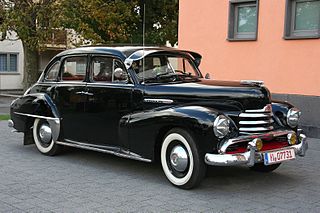
The Opel Kapitän is a luxury car made in several different generations by the German car manufacturer Opel from 1938 until 1970.

The Opel Admiral is a luxury car made by the German car manufacturer Opel from 1937 until 1939 and again from 1964 until 1977.

The Opel 4 PS, popularly known as the Laubfrosch (treefrog), is a small two-seater car introduced by the auto maker Opel early in 1924. Subsequently, various versions of the little Laubfrosch were produced until it was replaced by the Opel 1.2 litre.

The Mercedes-Benz W15 is an automobile produced by Mercedes-Benz from 1931 to 1936. Regarded today as a mid-size family car, it was given the chassis designation W15, and sold as the Typ 170 in four-door "Limousine" (sedan/saloon) and Cabriolet forms.

The Opel Kadett C is a small family car which was produced by the German automobile manufacturer Opel from 1973 to 1979. The Kadett C, which was the fourth generation of the Opel Kadett, was released in August 1973, and was Opel's version of the General Motors "T-Car". It was the last small Opel to feature rear-wheel drive, and remained in production at Opel's Bochum plant until July 1979, by which time Opel had produced 1,701,076. Of these, 52% had been exported outside West Germany, most of them to markets in other parts of western Europe. In other world markets, however, various badge engineered versions of the Kadett C remained in production as late as the mid-1990s under other GM brand names.

The Adler 2.5-litre was a sensation when first presented by Adler at the Berlin Motor Show early in 1937, although this did not convert into correspondingly sensational sales.

The Adler Primus is a small family car introduced by the Frankfurt based auto-maker, Adler in March 1932. In a move reminiscent of British Leyland in the 1970s, Adler launched two similarly sized cars in the same year, one of which followed the then new trend set by DKW for front-wheel drive, and one respecting the conventional rear-wheel drive configuration still used by the market leader, Opel.

The Adler Trumpf is a small family car introduced by the Frankfurt based auto-maker, Adler in March 1932, with Trumpf production fully starting in the late summer that year. In a move reminiscent of British Leyland in the 1970s, Adler launched two similarly sized cars in the same year, one of which followed the 1931 DKW F1's then innovative front-wheel drive layout, and the other model using the conventional rear-wheel drive configuration still used by then market leader, Opel's 1.2 litre 'model 6'.

The Opel 1,2 Liter is a small car manufactured by Opel between 1931 and 1935. The 1,2 Liter was replaced in 1935 by the Opel P4 which was broadly similar but employed a new engine and continued in production until December 1937. For just one year, in 1933, the manufacturer also offered the Opel 1,0 Liter which was a smaller engined version of the 1,2 Liter. The Opel 1,2 Liter replaced the last version of the Opel Laubfrosch and was itself first complemented and then effectively replaced by the more roomy Opel Kadett, which had itself already entered production in 1935.
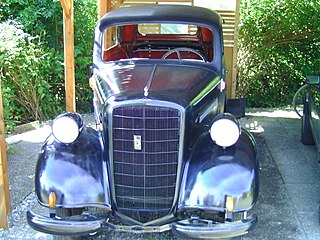
The Opel 1,3 Liter is a small car manufactured by Opel from 1934 to 1935. Production commenced in January 1934, although a few pre-production cars had been built during the final part of 1933.

The Opel 2 Liter, also known as the Opel »6«, is an executive car that was manufactured by Opel. Produced from January 1934, the 2 Liter replaced the Opel 1.8 litre which had ceased production in November 1933. Production continued till June 1937, but the replacement model, the Opel Super 6, was already in production in November 1936, after which production volumes for the 2 Liter were very much diminished.
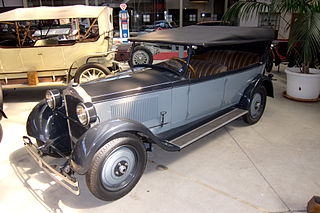
The Opel 7/34 PS is a large but relatively inexpensive six-cylinder-powered car manufactured by Opel, introduced in October 1927. It was replaced in 1928 by the Opel 8/40 PS which was virtually identical except that the cylinder capacity had been increased. Significant changes to the chassis took place in February 1929, after which production of the model continued till September 1930. The 8/40 PS was replaced by the Opel 1.8 Liter in 1931, also a compact six-cylinder car.
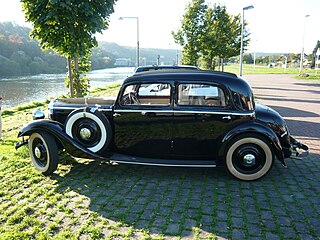
The Mercedes-Benz W 21 was a six-cylinder passenger car launched in 1933 using the name Mercedes-Benz Typ 200. It was one of several Mercedes-Benz models known, in its own time, as the Mercedes-Benz 200 and is therefore in retrospect more commonly referred to using its Mercedes-Benz works number, “W21”.
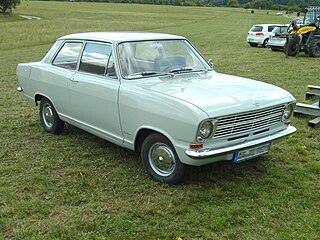
The Opel Kadett B is a car that was launched by Opel at the Frankfurt Motor Show in late summer 1965. The Kadett B was larger all-round than the Kadett A: 5% longer both overall and in terms of the wheelbase, 7% wider and 9% heavier, albeit 10 mm (0.39 in) lower in basic standard "Limousine" (sedan/saloon) form. Production ended in July 1973, with the successor model introduced a month later following the summer shut-down, in August. Unlike its predecessor, it bore no relation to the Vauxhall Viva, which had moved to its own platform for its corresponding second generation.





















